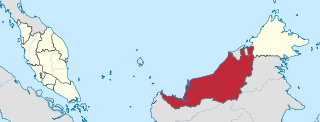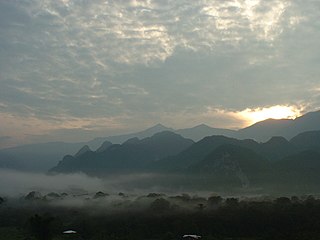
The Gunung Mulu National Park is a national park in Miri Division, Sarawak, Malaysia. It is a UNESCO World Heritage Site that encompasses caves and karst formations in a mountainous equatorial rainforest setting. The park is famous for its caves and the expeditions that have been mounted to explore them and their surrounding rainforest, most notably the Royal Geographical Society Expedition of 1977–1978, which saw over 100 scientists in the field for 15 months. This initiated a series of over 20 expeditions now named the Mulu Caves Project.
Sarawak Chamber is the largest known cave chamber in the world by area and the second largest by volume after the Miao Room in China. It is in Gua Nasib Bagus, which is located in Gunung Mulu National Park, in the Malaysian state of Sarawak on the island of Borneo.

Mount Murud or Muru is a sandstone mountain located in Limbang Division, Sarawak, Malaysia At 2,424 m (7,946 ft), it is the highest mountain in Sarawak.
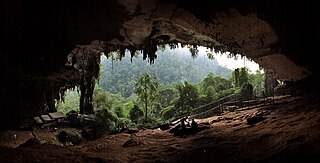
Niah National Park, located within Miri Division, Sarawak, Malaysia, is the site of the Niah Caves limestone cave and archeological site. Niah National Park was 31.4 km² when it was gazetted in 1974. Nomination for World Heritage status of the Niah Caves was sent to UNESCO in 2010.
"Gunung Buda National Park" is a national park located in Limbang Division, Sarawak, Malaysia. It is located to the north of Gunung Mulu National Park. The Gunung Buda National Park was gazetted in 2001. As in September 2017, the national park was in the planning stage for tourism activities. Roads were also planned to connect Gunung Buda with Gunung Mulu National Park.
Mount Benarat is a mountain located in Gunung Mulu National Park in Sarawak, Malaysia. Consisting of limestone on the western side which is overlain by gritstone on the eastern side. It contains many caves which have been discovered and explored by British and American cavers. The Benarat 2005 Caving Expedition discovered Moon Cave after climbing 60 m up the cliffs on the southern end of the mountain. On the eastern side, the Headhunter's Trail leads from the Melinau River to the mouth of the Terikan River at the Medalam River. Neighbouring Mount Buda and Mount Api are part of the same formation, separated from Mount Benarat by the Medalam and Melinau Rivers, respectively. It is also home to Benarat Cavern.
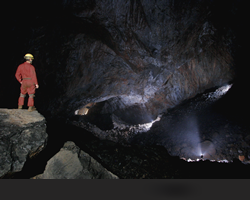
Api Chamber is a chamber in Whiterock Cave in Mount Api, Gunung Mulu National Park, Sarawak, Malaysia. Measuring 300 m by 200 m and with a surveyed circumference of 900 m it is the ninth largest cave chamber by area in the world. Its height is over 100 m and its plan area is 58,000 square metres. It is the second largest chamber in Malaysia, after Sarawak Chamber.

Batu Lawi is a twin-peaked mountain in the Kelabit Highlands of Sarawak, Malaysia (Borneo) that has played important roles in both ancient mythology and modern history. The taller 'male' peak is 2046 metres above sea level, while the female summit is at 1850 metres. It is one of the highest mountains in the state of Sarawak.

Malaysia is ranked 9th in the world for tourist arrivals. The Travel and Tourism Competitiveness Report 2017 ranks Malaysia 25th out of 141 countries overall, which was the fifth best in Asia.

Mount Pueh, also known as Mount Pueh-Berumput, Mount Poi and Mount Poe, is a mountain located near Lundu, Sarawak on the Malaysia-Indonesia border. Mount Pueh was known to biologists for the collections made there by Eric Mjöberg (1882–1938), a Swedish naturalist, who was Curator of the Sarawak Museum between 1922–1924. Mjöberg’s herpetological collections from Gunung Pueh between October to December 1923, and other localities in Borneo, were reported by Smith (1925). Mjöberg, unfortunately, left little by way of written records, of his ascent of Pueh and the collections he made.

Mount Mulu is a sandstone and shale mountain. At 2376 m, it is the second highest mountain in the state of Sarawak, after Mount Murud. It is located within the boundaries of Gunung Mulu National Park, which is named after it.

The Malayan tailless leaf-nosed bat is a species of bat in the family Hipposideridae. It is a very small bat which has long and soft fur. The fur coloration is brown to blackish on the dorsal surface and ashy on the ventral surface. It can be distinguished from the other roundleaf bats by its small size and the absence of the tail. It is listed as vulnerable by the IUCN
Gua Nasib Bagus or Lubang Nasib Bagus is a cave located in the state of Sarawak in Malaysia. It is one of many caves found within Gunung Mulu National Park, a World Heritage Site on the island of Borneo.
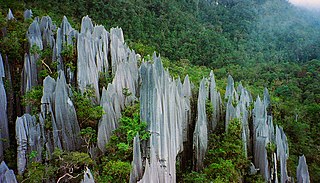
Mount Api is a limestone mountain located in Gunung Mulu National Park in Sarawak, Malaysia. Neighbouring Mount Benarat and Mount Buda are part of the same formation. Mount Api is famous for its striking limestone karst formations, commonly called "the pinnacles".

Deer Cave, located near Miri, Sarawak, Malaysia, is a show cave attraction of Gunung Mulu National Park. It was surveyed in 1961 by G. E. Wilford of the Malaysian Geological Survey, who predicted that Mulu would yield many more caves in the future. The cave, which is also known as Gua Payau or Gua Rusa by the local Penan and Berawan people, is said to have received its name because of the deer that go there to lick salt-bearing rocks and shelter themselves.

The Clearwater Cave System in Gunung Mulu National Park, Sarawak, Malaysia is believed to be the largest interconnected cave system in the world by volume and the 8th longest cave in the world at 222 km (138 mi) (2017). The system lies mainly under the western margins of Gunung Api between the Melinau Gorge and Cave of the Winds.
Lithocarpus muluensis is a tree in the beech family Fagaceae. It is named for Gunung Mulu mountain in Sarawak, Borneo.
